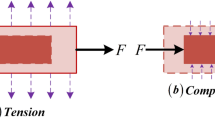Abstract
Modern flexible and sensitive sensors based on polymer–ceramic composites employ lead zirconate titanate (PZT) granulates having the morphotropic phase boundary (MPB) composition as the piezo active ingredient, as this composition gives the best properties in fully ceramic piezoelectric sensors. In this study, the possibility of using PZT granulates with compositions, which are not in the MPB region of the PZT phase diagram was investigated. Random 0–3 PZT–epoxy composites were prepared for the complete composition range of PZT ceramics [Pb(ZrxTi(1−x))0.99Nb0.01O3] with x ranging from x = 0 to x = 0.80. Piezoelectric and dielectric properties of such composites were systematically studied. It is shown that the highest voltage sensitivity (i.e. g33) of the piezoelectric composites is obtained for composition with much lower Zr levels (x < 0.1) than the MPB composition. The shift in optimal composition is related to shift in dielectric constant of PZT as a function of the Zr concentration.








Similar content being viewed by others
References
B. Jaffe, W.R. Cook Jr., H. Jaffe, Piezoelectric Ceramics (Academic Press, New York, 1971)
E. Boucher, B. Guiffard, L. Lebrun, D. Guyomar, Effects of Zr/Ti ratio on structural, dielectric and piezoelectric properties of Mn-and (Mn, F)-doped lead zirconate titanate ceramics. Ceram. Int. 32, 479–485 (2006)
M. Pereira, A. Peixoto, M. Gomes, Effect of Nb doping on the microstructural and electrical properties of the PZT ceramics. J. Eur. Ceram. Soc. 21, 1353–1356 (2001)
A. J. Moulson, J. M. Herbert, Electroceramics: Materials, Properties, Applications, 2nd edn. (John Wiley & Sons, 2003)
J.F. Tressler, S. Alkoy, R.E. Newnham, Piezoelectric sensors and sensor materials. J. Electroceram. 2, 257–272 (1998)
S.-Y. Chu, T.-Y. Chen, I.T. Tsai, W. Water, Doping effects of Nb additives on the piezoelectric and dielectric properties of PZT ceramics and its application on SAW device. Sens. Actuators A 113, 198–203 (2004)
R.E. Newnham, Composite electroceramics. Ferroelectrics 68, 1–32 (1986)
F. Li, R. Zuo, Bismuth sodium titanate based lead-free ceramic/epoxy 1–3 composites: fabrication and electromechanical properties. J. Mater. Sci.: Mater. Electron. 25, 2730–2736 (2014)
M.T. Sebastian, H. Jantunen, Polymer–ceramic composites of 0–3 connectivity for circuits in electronics: a review. Int. J. Appl. Ceram. Technol. 7, 415–434 (2010)
P.K. Mahato, S. Sen, Effect of surface modification of ceramic particles by SDS on the electrical properties of PZT–PVDF and BT–PVDF composites: interface effect. J. Mater. Sci.: Mater. Electron. 26, 2969–2976 (2015)
S. Dalle Vacche, Y. Leterrier, V. Michaud, D. Damjanovic, A.B. Aebersold, J.-A.E. Månson, Effect of interfacial interactions on the electromechanical response of poly (vinylidene fluoride–trifluoroethylene)/BaTiO 3 composites and its time dependence after poling. Compos. Sci. Technol. 114, 103–109 (2015)
F. Chengju, M. Wei, Q. Yan, H. Zhixiong, G. Dongyun, Damping property of epoxy-based composite embedded with sol–gel-derived Pb (Zr0. 53Ti0. 47) O3 thin film. J. Mater. Sci.: Mater. Electron. 22, 911–914 (2011)
C. Bowen, H. Kim, P. Weaver, S. Dunn, Piezoelectric and ferroelectric materials and structures for energy harvesting applications. Energy Environ. Sci. 7, 25–44 (2014)
E.K. Akdogan, M. Allahverdi, A. Safari, Piezoelectric composites for sensor and actuator applications. IEEE Trans. Ultrason. Ferroelectr. Freq. Control 52, 746–775 (2005)
M.C. Araújo, C. Costa, S. Lanceros-Méndez, Evaluation of dielectric models for ceramic/polymer composites: effect of filler size and concentration. J. Non-Cryst. Solids 387, 6–15 (2014)
T. Yamada, T. Ueda, T. Kitayama, Piezoelectricity of a high-content lead zirconate titanate/polymer composite. J. Appl. Phys. 53, 4328–4332 (1982)
C. Dias, D. Das-Gupta, Inorganic ceramic/polymer ferroelectric composite electrets. IEEE Trans. Dielectr. Electr. Insul. 3, 706–734 (1996)
J. Sheen, Z.-W. Hong, C.-W. Su, H.-C. Chen, Microwave measurements of dielectric constants by exponential and logarithmic mixture equations. Prog. Electromagn. Res. 100, 13–26 (2010)
H. Khanbareh, S. van der Zwaag, W. Groen, Effect of dielectrophoretic structuring on piezoelectric and pyroelectric properties of lead titanate–epoxy composites. Smart Mater. Struct. 23, 105030 (2014)
N. James, U. Lafont, S. van der Zwaag, W. Groen, Piezoelectric and mechanical properties of fatigue resistant, self-healing PZT–ionomer composites. Smart Mater. Struct. 23, 055001 (2014)
N.K. James, D. van den Ende, U. Lafont, S. van der Zwaag, W.A. Groen, Piezoelectric and mechanical properties of structured PZT–epoxy composites. J. Mater. Res. 28, 635–641 (2013)
I. Babu, G. de With, Highly flexible piezoelectric 0–3 PZT–PDMS composites with high filler content. Compos. Sci. Technol. 91, 91–97 (2014)
E. Venkatragavaraj, B. Satish, P. Vinod, M. Vijaya, Piezoelectric properties of ferroelectric PZT–polymer composites. J. Phys. D Appl. Phys. 34, 487 (2001)
B. Chambion, L. Goujon, L. Badie, Y. Mugnier, C. Barthod, C. Galez et al., Optimization of the piezoelectric response of 0–3 composites: a modeling approach. Smart Mater. Struct. 20, 115006 (2011)
D. van den Ende, B. Bory, W. Groen, S. van der Zwaag, Improving the d33 and g33 properties of 0–3 piezoelectric composites by dielectrophoresis. J. Appl. Phys. 107, 024107 (2010)
X. Lou, Polarization fatigue in ferroelectric thin films and related materials. J. Appl. Phys. 105, 024101 (2009)
Acknowledgments
This work was financially supported by the Smartmix funding program (Grant No. SMVA06071), as part of the “Smart systems based on integrated Piezo” program. The authors gratefully acknowledge the technical support provided by Dr. I. Katsouras of the Max-Planck Institute for Polymer Research at Mainz for the hysteresis loop measurements.
Author information
Authors and Affiliations
Corresponding author
Rights and permissions
About this article
Cite this article
Shaji Karapuzha, A., Kunnamkuzhakkal James, N., van der Zwaag, S. et al. On the use of non-MPB lead zirconium titanate (PZT) granules for piezoelectric ceramic–polymer sensorial composites. J Mater Sci: Mater Electron 27, 9683–9689 (2016). https://doi.org/10.1007/s10854-016-5029-9
Received:
Accepted:
Published:
Issue Date:
DOI: https://doi.org/10.1007/s10854-016-5029-9




